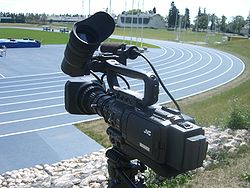- Electronics industry in Japan
-
The Japanese consumer electronics industry is one of the most prominent industries in the world and is the world's largest electronics manufacturer by companies such as Sony, Pentax, Casio, Citizen Watches, Hitachi, Mitsubishi Electric, Panasonic, Roland, Sharp, Canon, Epson, Yamaha, Sanyo, Fujitsu, Korg, Fujifilm, JVC Kenwood Inc, Toshiba, Pioneer, Nikon, TDK, Nintendo, Olympus, Star Micronics Co., Ltd etc.
Contents
History
After World War II, Japanese business began to rapidly develop consumer electronics products using keiretsu methods. By the 1980s, a relatively small number of industries dominated Japan's international trade and investment interaction with the rest of the world.
Sony was founded in 1946 by Masaru Ibuka and Akio Morita and rapidly advanced in the electronics field. The invention of the pocket transistor radio placed the company at the forefront of electronics development, both in Japan and worldwide. As other companies were formed to compete in this area, the consumer electronics industry became major exporters that invested overseas in the 1980s. In 1991, 46.7 percent of color televisions and 87.3 percent of video cassette recorders produced in Japan were exported. The export shares of some products were too small to show separately in summary trade data, however audio tape recorders represented 2.9% of total Japanese exports in 1988, video cassette recorders 2.3 percent, radio receivers 0.8 percent, and television receivers 0.7 percent, totaling 6.7 percent.[citation needed]
These industries built Japan's success in developing commercial applications for the transistor in the 1950s and generations of semiconductor devices of the 1970s and 1980s. Output came from large, integrated electronics firms manufacturing semiconductor devices, consumer electronics, and computers. The companies’ international success came from continually pushing miniaturization and driving down manufacturing costs.[citation needed]
The industry today
With a high concentration of electronics companies, dominant global market share in electronics, and high quality of its products, Japan is the largest consumer electronics manufacturer in the world.[1] Japanese companies have a reputation for high quality and innovation, having introduced products such as the Sony Walkman and VHS recorder.
Japan's success overpowered the United States consumer electronics industry. Unproved charges of dumping and other predatory practices led to orderly marketing arrangements by Japan in 1977. Restraints limited the export of color televisions to 1.75 million units annually from 1977 to 1980. The agreement gave some protection to the United States' domestic industry. Japanese companies responded by investing in the United States, by the end of the 1980s, only one United States-owned television manufacturer remained.[citation needed] The Japanese electronic industry as a result has maintained its dominance in the market over the United States, and maintained its export strength in this field due to the high reputation of its electronics.
Japan's foreign direct investment in the consumer electronics industry was motivated by protectionism and labor costs. After three years of voluntary export restraints, seven Japanese firms located plants in the United States by 1980. Japanese firms continued production of the most technologically-advanced products especially in Japan but also U.S., while shifting production of less-advanced products to developing countries, such as Taiwan[dubious ].
Since the beginning of the 21st century Japanese electronics companies have been facing tougher competition from South Korean companies. For instance, Samsung Electronics’ operating profit is more than two times larger than the combined operating profit of nine of Japan’s largest consumer electronic companies.[2] With Japanese companies losing their top position in categories like portable media players, TVs, computers and semiconductors.[3] Hit hard by the economic crisis of 2008 Sony, Hitachi, Panasonic, Fujitsu, Sharp, NEC and Toshiba reported losses amounting to $17 billion.[4] This has forced some of the smaller players like JVC and Kenwood to merge forming JVC Kenwood Holdings,[5] and Renesas Technology and NEC Electronics -the semiconductors arm of NEC- to merge forming Renesas Electronics.[6] In a similar move, in 2009 Panasonic acquired a voting stock majority of Sanyo, making the latter part of the Panasonic Group. Also some of the bigger players resorted to merging some of their operations as Hitachi, Casio and NEC, and Fujitsu and Toshiba, did with their cellphone business.[7]
References
 This article incorporates public domain material from websites or documents of the Library of Congress Country Studies.
This article incorporates public domain material from websites or documents of the Library of Congress Country Studies.- ^ Yoshiko Hara. "Japan's IC needs met at home". EETimes. http://www.eetimes.com/electronics-news/4048822/Japan-s-IC-needs-met-at-home.
- ^ http://online.wsj.com/article/SB125732757764927689.html
- ^ Winning the global challenge: The Japanese electronics companies' race to innovate
- ^ "Japanese electronics giants post $17b losses". http://www.abc.net.au/news/stories/2009/01/30/2478955.htm.
- ^ Erica Ogg. "JVC, Kenwood officially hook up". CNET. http://news.cnet.com/8301-10784_3-9941913-7.html.
- ^ "Renesas Electronics is biggest 'non-memory' chip firm". ElectronicsWeekly.com. 2 April 2010. http://www.electronicsweekly.com/Articles/2010/04/02/48342/renesas-electronics-is-biggest-non-memory-chip-firm.htm. Retrieved 2010-04-03.
- ^ "Fujitsu, Toshiba agree to merge mobile phone businesses". http://japantoday.com/category/technology/view/fujitsu-toshiba-agree-in-principle-to-merge-mobile-phone-businesses.
External links
- Japan Electronics and Information Technology Industries Association (JEITA)
- Japan Electric Manufacturers' Association (JEMA)
- Japan Refrigeration and Air Conditioning Industry Association (JRAIA)
- Japan Electric Measuring Instruments Manufacturers' Asscociation (JEMIMA)
- Association for Electric Home Appliances (Japanese)
- Industrial Structure Vision 2010 (METI) (English) (full report, Electronics and IT sectors, Functional Chemical sector (p.190)(Japanese))
- Japan
Categories:
Wikimedia Foundation. 2010.


